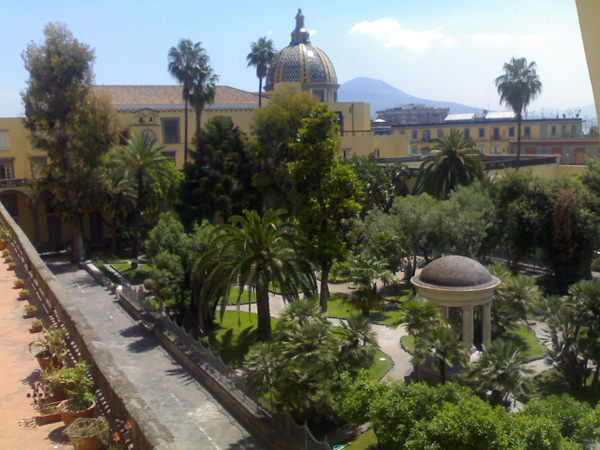
17th Bathurst Meeting
International Meeting of Carbonate Sedimentologists
Naples, Italy • 5-7 September 2023



The Meeting will be hosted in the Monumental Complex of Donnaregina, in the heart of the historical center of Naples. The sessions will take place in the central navy of the baroque church, richly ornamented by multicolored marble inlays. The Poster sessions and coffee break will be hosted in the “old” Gothic churc of the Complex, with possibility to have a coffee and discuss in a small nearby cloister. Several other spaces will be available for microscope facilities, small meetings and informal chats.



A guided tour of the Complex and its museal exposition will be offered to the participants .
The Icebreaker Party will start at 18.00 in Largo San Marcellino 10 (https://goo.gl/maps/JKJCyg9D59iVghqaA ), in the XVII century cloister which has been for more than a century (until 2018) the location of the Geological, Paleontological and Geophysical Institutes of the University of Naples. It still hosts the Paleontological Museum , part of the Centro Musei of the Federico II University.

The international airport of Napoli Capodichino is connected to Piazza Garibaldi by a rapid bus line called “Alibus” .
Piazza Garibaldi is also the location of the main railway station, well connected to Rome (to the north) and Salerno (to the south). Italian railways are operated by Trenitalia and Italotreno .
The venue of the meeting, Complesso Monumentale Donnaregina, is within walking distance from the following metro stations:
Naples is a town with an enormous cultural heritage, which deserves weeks for a full visit. We suggest you to not miss, in the close surroundings of the Complesso Donnaregina:
If you plan to stay longer, we suggest having a look at the following web pages:
Artecard Naples
Comune di Napoli
Naples is the third largest city of Italy. It hosts barely one million of inhabitants but together with its surroundings it embodies a densely populated metropolitan area which host, in the world-famous scenario of its bay, a intricated melting pot of history and cultures as well as geological landscapes.
The town lays between the Vesuvius volcano to the SE and the Campi Flegrei volcanic field at the west, which create the northern closure of the Bay. The town itself is built above an hilly landscape shaped mainly by the explosive volcanic eruption of Tufo Giallo Napoletano some 15ky ago. The southern branch of the Bay, together with its western prosecution represented by Capri Island, is instead mainly built by Mesozoic shallow-water thick carbonate successions which records a long-lasting history of platform carbonate sedimentation. These limestones and dolomites, together with minor siliciclastics and volcanics, provide a completely different landscape, with huge carbonate cliffs and gentle terraces with orange and limon trees cultivations.
Since its remote origin it has been a meeting point of west and east of the Mediterranean world. Founded as a Greek colony in the VI century B.C., it developed through the mixing of the Hellenic, Italic and Etruscan populations in Roman time. Its coasts were elected by Roman emperors and patricians as a favorite site for vacation and relax. However, the nearby Pozzuoli was also a fundamental port for trade with the Hellenic and Egyptian worlds and the location of the powerful Roman fleet. The volcanic ashes of Pozzuoli, known as Pozzolana, was instrumental for the Roman technological primacy in building aqueducts and ports all around Mediterranean.
The iconic Castel dell’Ovo was the prison of the last Roman Emperor, Romolo Augustolo. Afterward, the town developed under the contrasting influence of Longobard and Bizantine world after experiencing the sequential dominion of Normans, Germans, Catalans, French and Spanish. During the most blessed period of its history, the XVIII Century, Naples was the capital of the independent Kingdom of Two Sicilies and one of the largest and culturally influential city in Europe. A favorite target of the Grand Tour, because of the discovery of Herculaneum and Pompey and the birth of archeology, it was also instrumental in developing modern geology with the studies by William Hamilton in the Campi Flegrei, who recognized the importance of volcanism in Earth history, and the choice of Charles Lyell to erect the so-called Temple of Serapis of Pozzuoli as an icon of his vision of the Geological Time.
Embodied to the Italian Kingdom in 1861, the town has progressively lost its character of a great capital but has preserved its enormous cultural potential in music, literature and science and its flavor of a multicultural city. Today Naples is experiencing an impressive growth of tourism with an increasing valorization of its tremendous archeological, artistic and natural heritage.